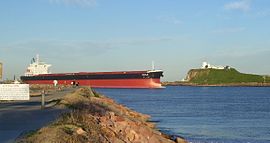
Back Hunter Valley German Hunter Region Esperanto Valle de Hunter Spanish منطقه هانتر Persian Région de l'Hunter French Wilayah Hunter ID ハンター地域 Japanese 헌터밸리 Korean Hunter Valley NB Hunter (region) Polish
| Hunter Region New South Wales | |||||||||||||||
|---|---|---|---|---|---|---|---|---|---|---|---|---|---|---|---|
 View across the Hunter Valley | |||||||||||||||
 The mouth of the Hunter River at Newcastle | |||||||||||||||
| Coordinates | 32°33′36″S 151°10′15″E / 32.56000°S 151.17083°E | ||||||||||||||
| Population | 682,465 (2021)[1][note 1] | ||||||||||||||
| • Density | 30.07222/km2 (77.88670/sq mi) | ||||||||||||||
| Area | 22,694.2 km2 (8,762.3 sq mi) | ||||||||||||||
| Time zone | AEST (UTC+10) | ||||||||||||||
| • Summer (DST) | AEDT (UTC+11) | ||||||||||||||
| Location | 162 km (101 mi) N of Sydney | ||||||||||||||
| LGA(s) |
| ||||||||||||||
| State electorate(s) | |||||||||||||||
| Federal division(s) | |||||||||||||||
| |||||||||||||||
The Hunter Region, also commonly known as the Hunter Valley, Newcastle Region, or simply Hunter, is a region in northern New South Wales, Australia, extending from approximately 162 km (101 mi) to 310 km (193 mi) north of Sydney. It contains the Hunter River and its tributaries with highland areas to the north and south.[2] Situated at the northern end of the Sydney Basin bioregion, the Hunter Valley is one of the largest river valleys on the NSW coast, and is most commonly known for its wineries and coal industry.
Most of the population of the Hunter Region lives within 25 km (16 mi) of the coast, with 55% of the entire population living in the cities of Newcastle and Lake Macquarie. There are numerous other towns and villages scattered across the region in the eleven local government areas (LGAs) that make up the region. At the 2021 census the combined population of the region was 682,465, and is expected to reach over 1,000,000 people by 2031.[3] Under Australia's wine appellation system, the Hunter Valley wine zone Australian Geographical Indication (GI) covers the entire catchment of the Hunter River and its tributaries. Within that, the Hunter region is almost as large, and includes most of the wine-producing areas, excluding the metropolitan area of Newcastle and nearby coastal areas, some national parks, and any land that was in the Mudgee Shire (at the western heights of the catchment).
The Hunter wine region is one of Australia's best known wine regions, playing a pivotal role in the history of Australian wine as one of the first wine regions planted in the early 19th century. The success of the Hunter Valley wine industry has been dominated by its proximity to Sydney with its settlement and plantings in the 19th century fuelled by the trade network that linked the Hunter Valley to Sydney. The steady demand of consumers from Sydney continues to drive much of the Hunter Valley wine industry, including a factor in the economy by the tourism industry.[4] While the Hunter Valley has been supplanted by the massive Riverina wine region as the largest producer of New South Wales wine, it still accounts for around 3% of Australia's total wine production and is one of the country's most recognisable regions.[5]
- ^ "Regional population, 2019-20 financial year". Australian Bureau of Statistics. 30 March 2021. Archived from the original on 30 March 2021. Retrieved 18 December 2021.
- ^ "Department of Local Government – Regions". NSW Department of Local Government. Archived from the original on 9 August 2007. Retrieved 5 August 2007.
- ^ "Hunter, Central Coast population to top million mark within decades". ABC News. 9 September 2013. Archived from the original on 3 May 2022. Retrieved 3 May 2022.
- ^ Johnson, Hugh, and Jancis Robinson. The World Atlas of Wine. London: Mitchell Beazley, 2005. Print.
- ^ Clarke, Oz, and Margaret Rand. Oz Clarke's Encyclopedia of Grapes. New York: Harcourt, 2001. Print.
Cite error: There are <ref group=note> tags on this page, but the references will not show without a {{reflist|group=note}} template (see the help page).
© MMXXIII Rich X Search. We shall prevail. All rights reserved. Rich X Search
